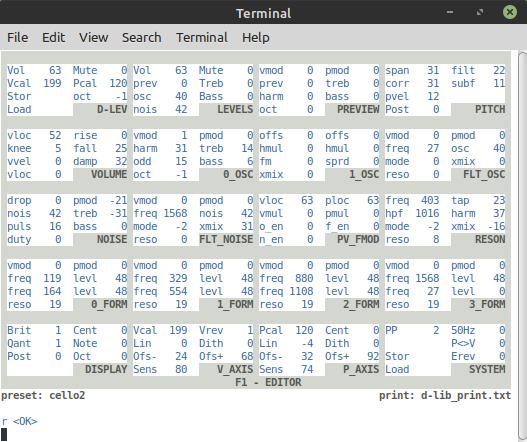Cello v2.0.0.0.1a
The D-Lev has 8 formants and my cello patch was only using 6, and now 7, so just for the heck of it I guesstimated the inter-formant distance and added one to the top end at 1975 Hz, at the same level (levl = 48) as the others. It makes a noticeable and IMO positive difference, as it opens up the top end (adds "air" as audiophiles like to say) and makes the pseudo stereo effect somewhat more pronounced. A quick sample (with some added reverb, sorry couldn't help myself): [MP3]. Roger, I'll send you the *.dlp file in a sec.
"Your sample has a much more pleasing and fuller bass from what I remember, although there is a little too much peaking somewhere in there, unless that's a recording issue." - pitts8rh
I run pretty close to the rails when recording, so it's probably that?
"It would be nice to have access to these stringed instruments just to be able to do tap tests to get a better idea of the natural resonances, or maybe something like this already exists out there."
IIRC, one older paper excited the modes by driving the strings with an electromagnet, sort of an inside out electric guitar setup. Tapping (impulse response) should give the resonances, but you have to trust how they massage the data.
I've found it's pretty easy to just eyeball the resonances of a decent anechoic recording. The lowest notes have the most harmonics, so you only need to examine the bottom octave or so in order to resolve the major resonance frequencies. But this doesn't give you Q's or levels, and it would be nice to have all of this analysis and synthesis more scientific and nailed down and automatic.
"I keep trying the resonator frequency higher and lower, and within reason they both sound okay but if you don't have a good reference you can really start drifting away from the real thing."
The resonator is a crazy thing, using it is unfortunately largely a monte-carlo effort. The way it can do OK human vocals with no other filtering assist was a real shocker.
"Man, those resonances that are so important for the string sound are just brutal for highlighting pitch errors. I've had to scale back vibrato movements from a wrist-induced forearm movement to about half the displacement, which is tough to do because it has no natural resonance (I'm talking about physical arm movements). I don't know where the happy medium is for this timbre/playability tradeoff. I wonder if the natural instrument resonances also mess with player's pitch perception too?"
I know what you mean. When coming off of playing the ultra-pitch-forgiving whistle for a while to the cello I go instantly from a B- student to D+. Stringed instruments generally have a slower vibrato than my natural arm/hand resonance, so that's been difficult to remember and do. And it's been a real challenge, particularly on the violin patch, to get rid of (i.e. dial out of the patch) those strange squeaky sounds that vibrato accentuates. I wonder if the resonance frequencies themselves cause players to go sharp or flat when playing notes that run counter to them?
"I don't hear much difference between -2 and -1 for "mode". What is the difference?"
In the more recent SW (since 2020-05-30) the resonator modes go like this (before that + and - were swapped, sorry for any confusion):
2 : serial pseudo stereo
1 : serial (reverb)
0 : formant bypass (variable w/xmix)
-1 : parallel (formant fill)
-2 : parallel pseudo stereo
So if you are monitoring in stereo, I'd use mode -2 for the string patches.



